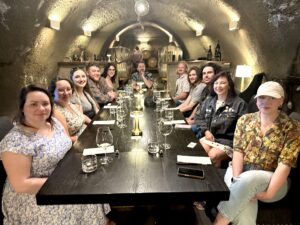Wondering how to cleanse your palate for wine tasting? NW Wine Shuttle has you covered!
Wine tasting is an activity that can be enjoyed by anyone, regardless of experience. The key to an enjoyable experience is to ensure the palate is clean and free from any lingering flavors.
This article will provide a comprehensive guide on how to effectively cleanse the palate prior to engaging in the wine tasting process. You’ll also learn how to cleanse your palate between tastings.
The importance of cleansing the palate cannot be understated; it allows tasters to appreciate the flavor and aroma components of each wine, allowing them to make more accurate assessments and evaluations.
To ensure a successful and enjoyable wine tasting experience, it’s essential that tasters understand the best practices for cleansing their palates.
Looking to experience wine tasting in Portland, Oregon? Contact us now to book your tasting!
Consuming water between drinks is a key component of cleaning the palate to properly differentiate and enjoy the nuances of the various wines.
Hydration benefits are important to maximize the enjoyment and appreciation of different wines.
Mineral water provides a unique balance of flavors and minerals which can be used to cleanse the palate while still providing an enjoyable drinking experience.
Tap water can be used as well; however, it’s important to ensure that it’s filtered and free of impurities. These may interfere with the tasting experience.
Sparkling water offers a refreshing contrast to wine and can be an excellent way to reset the palate for further tasting. But it should be noted that sparkling mineral or tap waters should not contain any added flavors as this could interfere with the tasting experience.
Unsalted crackers are another option for cleansing the palate between wine tastings. The variety of cracker types available ensures that there is a flavor pairing to suit most taste preferences.
The texture of unsalted crackers also provides a contrasting sensation to the smoothness of the wines. This can be used to effectively reset the palate for further tasting.
Comparisons can be made between different types of unsalted crackers and their respective flavors. This should help you to determine which best pairs with any given wine.
Ultimately, these types of crackers provide an effective cleansing agent for enhancing wine appreciation while also providing a light snack during longer tasting sessions. In essence, they offer an ideal balance of flavor and texture when it comes to taste testing wines.
Citrus fruits can be used as an effective means of cleaning the palate between drinks. In addition to providing a refreshing break, they offer a variety of health benefits and flavor profiles that can be used to pair with different wines.
For instance, the tartness of lemons or limes can provide a contrast to sweeter wines and bring out their nuances in a unique way. Oranges and grapefruits offer a more subtle sweetness that pairs well with many varieties of white wines and sparkling beverages.
Not only are citrus fruits ideal for cleansing the palate, but they also provide antioxidants and vitamins that make them an excellent choice for healthier snack options during longer tastings. Using citrus is an excellent way to reset the palate while providing additional nutritional value.
Loving this article? Make sure to check out our other post about how to perform a virtual wine tasting before you leave!
When it comes to wine tasting, palate training is essential for recognizing flavor notes and distinguishing between different types of wines. To ensure an enjoyable experience, engaging in the proper preparation before and after a tasting is key. Beforehand, eating salty or acidic foods like olives, chips, nuts, or citrus fruits can help to prime the palate while neutralizing any lingering tastes.
Between wines, a light snack with sweet elements such as fruit or cheese can provide a pleasant finish and further enhance the tasting process. This helps to recall specific flavor notes of each variety.
The number of wines an individual should taste in one session is a matter of personal preference and experience. Generally, for those new to wine tasting, it is best to aim for between three and five wines.
For those more experienced, between six and eight wines can provide a better comparative tasting; however, this can be too much for some as there is a risk of palate fatigue.
To ensure the best experience possible, it is important to practice scent sampling and palate training prior to the session, as well as researching which wines pair well together.
Ultimately, the number of wines tasted should depend on the individual’s comfort level and ability to appreciate subtle differences in flavor.
Tasting good wine is an art form that requires a discerning eye and a keen palate — and the following techniques will help you to tell the difference between good and bad wine. Most importantly, recognize the nuances of different food pairings. This can help you assess how well the flavors of the wine will work with your meal.
When tasting wines, it is important to cleanse your palate often in order to identify the nuances of a particular varietal or note the effects of wine aging. Generally speaking, experts suggest cleansing your palate every two to three wines in order to ensure that you can accurately discern differences in flavor, alcohol content, and pairings with water.
It is important to consider the order in which one tastes wines when conducting a wine tasting. According to a survey conducted by The Wine Institute, it was found that almost 80% of professional tasters practice tasting wines in a particular order.
While there’s no single accepted order for tasting wines, some experts recommend beginning with lighter-bodied, younger white wines and progressing to fuller-bodied and aged reds. To get the most out of each wine, pairing foods together with different varietals can help identify flavors and enhance the overall tasting experience.
You now know how to cleanse your palate for wine tasting. But keep in mind that the art of wine tasting is one that requires the taster to be in tune with both their senses and their emotions. With a few simple techniques, one can master the skill of discerning between good and bad wines.
By cleansing the palate frequently, paying attention to aromas and flavors, and tasting wines in an order that allows for comparison, a taster can get the most out of any wine experience.
As if reading music notes on a page, a taster must learn to recognize and appreciate the subtleties of each wine, just as one would distinguish between different instruments in an orchestra.
In doing so, they will find themselves becoming increasingly attuned to their own sensory thresholds. With practice comes perfection; it’s only through experience that one can truly become an expert in the field of wine tasting.

Wine tasting is an unforgettable experience, but the checkout process can feel like a small hurdle in your perfectly planned day. At NW Wine Shuttle,

Looking for the best unpretentious wineries in McMinnville? You’re in luck! In the realm of wine tasting, finding a winery that offers a genuine and
WINE TRANSPORTATION & TOURS
Business Location (not for consumers)
9140 Hwy 47 #697
Carlton, OR 97111
Phone
971-264-1555
WATCH, LISTEN, & LEARN
FOLLOW US
NW Wine Shuttle, Copyright © 2025. All rights reserved.